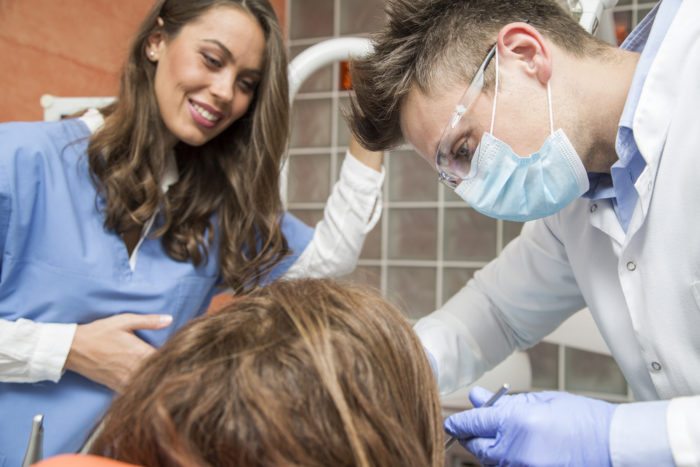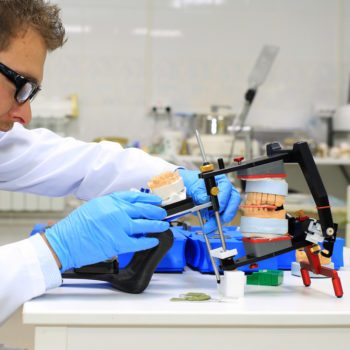Why We Love It
-
$36,920Potential Avg. Salary
-
18.4%Job Growth Rate
-
Growing DemandJob Outlook
-
Dependable Daily WorkloadCareer Attribute
Orthodontic assistants provide support to orthodontists—dentists that specialize in installing and maintaining braces. They work with patients to prepare them for braces installation by taking x-rays and impressions, and they may also work in dental labs to create and polish retainers and mouth guards.
Recommended Schools
What is an Orthodontic Assistant?
The following job responsibilities are common for individuals in orthodontic assistant roles:
- Prepare rooms for patients and clean orthodontic tools before and after visits
- Take x-rays, photographs, and impressions of a patient’s teeth to aid in the preparation and application of braces
- Assist orthodontists in performing procedures by installing wires onto braces or tightening braces during routine exams
- Assist in labs by creating molds from impressions and creating retainers and/or mouth guards
- Educate patients on how to properly care for their braces
A Day in the Life of an Orthodontic Assistant
Orthodontic assistants provide support to dentists that specialize in the installation and maintenance of braces. In some ways, the role of an orthodontic assistant is similar to that of a dental assistant. Both roles take x-rays, prepare rooms for patients, and clean equipment used by the dentist during procedures. However, the orthodontic assistant role is a bit more independent because many of his/her tasks can be performed without the assistance of the orthodontist.
For example, in some states, the orthodontic assistant is able to tighten a patient’s braces during routine examinations. This means that the patient spends the majority of his/her time with the orthodontic assistant and may only see the orthodontist for a few minutes for a quick review at the end of the appointment. The orthodontic assistant may also be able to install wires on braces after the orthodontist has installed the braces brackets on a patient’s teeth.
Additionally, some orthodontic assistants also do work in dental labs to help create and prepare equipment. Orthodontic assistants may create retainers or mouth guards using impressions they took of the patent’s teeth. Additionally, they may polish equipment made by dental lab technicians to ensure that equipment is free of rough spots or other malformations that could irritate a patient’s mouth. Finally, orthodontic assistants also teach patients how to care for their braces after installation.
Typical Work Schedule for Orthodontic Assistants
Most orthodontic assistants work full-time. Occasionally, an orthodontist’s office may be open on the weekend, so weekend shifts may be required. Orthodontic assistants are rarely required to work overtime.
Projected Job Growth for Orthodontic Assistants
Job growth is anticipated for all dental careers—including orthodontic assistants—in the coming decade because of wider access to dental insurance and an increased concern about dental health and oral cosmetics in recent years.
Typical Employers
Most orthodontic assistants work for orthodontists that either operate their own practices or share a practice with a group of partner dentists.
Recommended Schools
How To Become an Orthodontic Assistant
The requirements for working as an orthodontic assistant depend on the state you intend to practice in. Each state has varied requirements for the credentials required of an orthodontic assistant, and each state has its own regulations on the types of tasks orthodontic assistants are allowed to perform. In some states, no formal degree is required to work as an orthodontic assistant. In those states, assistants are trained on the job by orthodontists or other assistants and need only a high school diploma.
In other states, orthodontic assistants must be licensed. If your state requires licensure, you’ll need to complete either a certificate or associate’s degree program in dental assisting. These 1- to 2-year programs provide education on patient administration, safe handling of x-ray equipment, and practical training on the tasks you’ll be required to perform in your role. After completing the certificate or degree program, you’ll be able to take an exam to become licensed, if required, in your state.
Even if state regulations don’t require completion of a certificate or degree program, completing a training program can be a positive career-boosting step for aspiring orthodontic assistants. A certificate or degree can help you get your foot in the door with practicing orthodontists who do not have the time to fully train new assistants. Additionally, the specialized training provided will allow you to perform more tasks in your role, making you a more valuable asset to potential and existing employers.
Orthodontic Assistant Salary Data
We’ve provided you the following to learn more about this career. The salary and growth data on this page comes from recently published Bureau of Labor Statistics data while the recommendations and editorial content are based on our research.
National Anual Salary
Low Range
$29,580Average
$36,920High Range
$50,660National Hourly Wage
Low Range
$14/hrAverage
$18/hrHigh Range
$24/hrHow do Orthodontic Assistant salaries stack up to other jobs across the country? Based on the latest jobs data nationwide, Orthodontic Assistant's can make an average annual salary of $36,920, or $18 per hour. This makes it an Above Average Salary. On the lower end, they can make $29,580 or $14 per hour, perhaps when just starting out or based on the state you live in.
Salary Rankings And Facts
#587 Nationally for All Careers
Highest Education Among Orthodontic Assistants
- 1.6% Doctorate
- 0.5% Masters
- 7% Bachelors
- 17.8% Associates
- 40.5% College
- 29.9% High School
- 2.7% Less than High School
Job Growth Projections and Forecast
2014 Total Jobs
318,8002024 Est. Jobs
377,400Job Growth Rate
18.4%Est. New Jobs
58,600How does Orthodontic Assistant job growth stack up to other jobs across the country? By 2024, there will be a change of 58,600 jobs for a total of 377,400 people employed in the career nationwide. This is a 18.4% change in growth over the next ten years, giving the career a growth rate nationwide of Below Average.
Growth Rankings And Facts
#68 Nationally for All Careers
What Companies Employ The Most Orthodontic Assistants
| Industry | Current Jobs | New Jobs Needed | % Increase |
|---|---|---|---|
| Offices of dentists | 290,100 | 54,300 | 54% |
| Offices of physicians | 6,400 | 1,400 | 1% |
| Federal government, excluding postal service | 4,200 | -400 | 0% |












